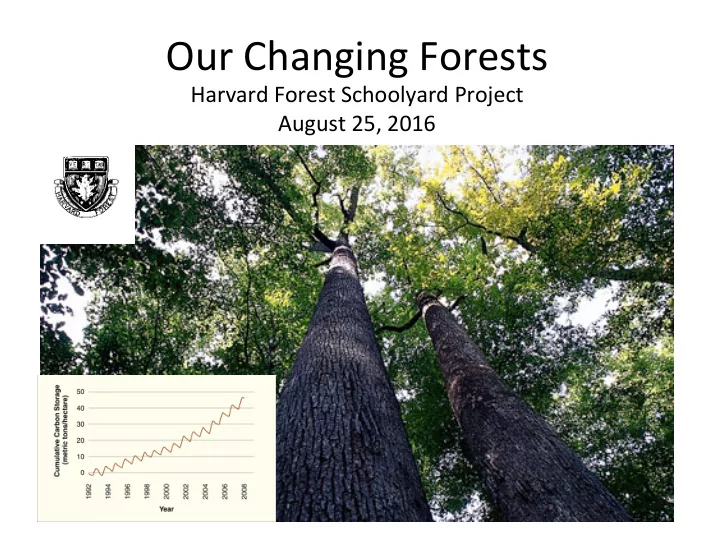

Our Changing Forests Harvard Forest Schoolyard Project August 25, 2016
1. How do forests change? 2. What are the implicaGons of forest change? 3. How do we measure forest change?
How do forests change? • New trees get established • Trees grow • Trees die reproducGon Seed survival Seedling survival Tree
Disturbance Background • – Weather – ice, snow, wind, hurricanes Pre-colonial • – Fire, in some places Colonial – Early Industrial • – Forest clearance (lumber, farming, ciGes) – Fire Modern • – Forest regrowth – Forest fragmentaGon – Atmospheric polluGon – Pest outbreaks Future • – Climate change – Development – PolluGon
ImplicaGons of forest change • Species composiGon
ImplicaGons of forest change • Forest structure carbon carbon
ImplicaGons of forest change Carbon Storage
How do we track forest change? • Plots • Used by ecologists, conservaGonists, land managers around the world
Changing Forests Protocol 10 meters Year 1 1. Establish and permanently mark at least one 10 x 10 meter square plot 2. Measure all trees and shrubs at least 2.5 cm in 10 meters diameter a. record species b. record the tree diameter at “breast height” c. record whether alive or dead d. mark each stem with a numbered tag 3. Record field site characterisGcs about the plot Year 2 Establish 2 nd 10 x 10 meter plot
Changing Forests Protocol • Return to each plot every 2-3 years and repeaGng tree measurements. • Comparing iniGal measurements to subsequent measurements to determine change over Gme
Where do you Put your Plot? • What forest do you have available near your school? • What type of forest do you want to study? (old, young, hemlock, oak etc. Hints: • At least 8-10 trees in the plot • Not too conspicuous • Basic Monitoring (schoolyard): examines what is changing in the plot, but does not address why changes are occurring) • ComparaLve or QuesLon Driven Monitoring (advanced): how is a parLcular disturbance changing the forest
Laying out the Plot E N 10 meters S W 10 meters Hint: set up two sides of the square and then check the diagonal (14.2meters). Find where 14.2 meters meets up with 10 meters in corner. Repeat with diagonal for other two sides.
Data Sheet-Field Site DescripGon Harvard Forest Schoolyard Ecology Our Changing Forests Field Site DescripLon Sheet School Name: ____________________Date (month, day, year):______ ____ Teacher Name: ______________________________________________ Plot Number_______ __________ Survey Number___________________ Time Start: Time End Plot LocaGon: County ___________ State ______ Town_____________ GPS Coordinates : Lat____________ Long _____________ Addi0onal Direc0ons Plot: _____________________________________
Data Sheet-Field Site DescripGon Topography/Physical Features : 1. Landscape posi.on – Check one: ridge/hilltop hillside dry flat wet flat rolling upland 2. Slope – Check one: none slight moderate steep 3. Aspect _____ ⁰ 4 . Water in Plot – Check one or more: stream temporary stream flooded area vernal pool 5. Rock Cover in Plot – Check one: <1% 1-5% 6-25% 26-50% 51-75% >75%
Data Sheet-Field Site DescripGon Forest Canopy CharacterisLcs: • Canopy Cover Es0mate : (Check One) 1-25%, 25-50%, 51-75% 76-100%
Data Sheet-Field Site DescripGon Evidence of Disturbance: 1. Forest Pests and Pathogens in Plot : Check one or more: Hemlock Woolly Adelgid Gypsy Moth Ash Yellows Asian Long-horned Beetle Beech Bark Disease Emerald Ash Borer Hemlock Borer other--___________ None
Data Sheet-Field Site DescripGon Evidence of Disturbance: 2. Human Ac.vity in or Near Plot : Check one or more cut stumps footpath stone wall forest road building cellar hole barbed wire open field skid trail other_______ None
Data Sheet-Field Site DescripGon Evidence of Disturbance: 3. Weather Events in Plot : Check one or more uprooted trees snapped trees large downed branches fire scars river flooding other_____ None 4. Downed Woody Debris Cover in Plot (pieces at least 10 cm in diameter): Check one: <1% 1-5% 6-25% 26-50% 51-75% >75%
Data Sheet-Field Site DescripGon Evidence of Disturbance: 5. Wildlife Sign in Plot: Check one or more deer pellets moose pellets deer/moose browsing moose bark-stripping deer antler rubs tree girdling [porcupine] beaver felled tree woodpecker hole bear claw marks on beech rabbit/porcupine browse other__________ None
Data Sheet-Field Site DescripGon Evidence of Disturbance: 6. Invasive Plant Species in Plot : Check One or More: Garlic Mustard Oriental Bilersweet Japanese Barberry Burning Bush MulGflora Rose Honeysuckle Autumn Olive Buckthorn Japanese SGlt Grass Other None
Tree IdenLficaLon Tree Species Diameter at CondiLon Number Breast Height (living, dead) (DBH) Record all stems > 2.5cm DBH #### Chestnut Oak 45.6 Alive woodlandstewardship.org
Measuring the diameter of unusual stems
Recommend
More recommend